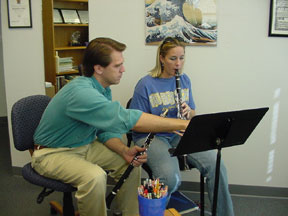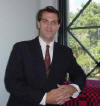|
Guidelines for Good Clarinet Practicing by |
When discussing good practice habits, the most important item to remember is that there is no substitute for efficient, daily practice. The practice time should be a time of intense concentration for the musician. It should be done away from any distractions such as busy rooms, TV or computers, or the stereo.
It is ideal if the room is not too dead in sound, which is discouraging, or so live that the sound is too enhanced. Larry Combs, Principal Clarinetist of the Chicago Symphony, has written a superb article titled, "How to Practice Effectively" which can be found in the March 1985 issue of the Instrumentalist. Much of the information below was organized around this article.
There are two questions most commonly asked regarding practicing. The first is: "How much should I practice?" The second is: "How should I practice?" Let's look at the first question.
"How should I practice?"
Any practice session should begin with several minutes of easy, sustained playing which avoids any extremes of range or dynamics. On most instruments, this is best accomplished by the playing of long tones. A good long tone warm-up (advocated by Larry Combs in his article in the Instrumentalist) can be practiced by starting on low C and holding this tone for four slow counts. Then, without stopping the air, depress the register key to produce a G just above the staff. Hold this G for four slow counts also, then descend in a major arpeggio (in this case a C major arpeggio since it started on C), and hold each pitch for two slow counts. When the bottom C is reached, hold this tone for as long as the breath allows. This process can be repeated for other lower notes in the clarinet's range.
After several minutes of long tones, scales and arpeggios should be the next area of practice. The importance of scales cannot be overstated. Most conventional music that is played today is constructed of scales and arpeggios in some form, and being able to play these building blocks fluently is of utmost importance. By knowing scales well, the player can then recognize groups of notes that fit into the scale or arpeggio and play the group without having to read each individual note. There are several books and scale methods. Some of the best are the Jettel and Klose methods which have a comprehensive set of exercises for practicing the scales in thirds, fourths, fifths, sixths, and sevenths as well as the traditional way. Be sure to practice your scales in different articulations. These are:
|
 |
Generally, it is a good idea to play the scale all slurred first. Concentrate on the scale and the air stream. The quality of the slurred sound will always be better than the tongued sound. When practicing tongued articulations, make an effort to maintain good sound quality by constantly trying to make the tongued sound the same quality as the slurred sound.
Before moving on to etudes, a useful area of study can be fingering "noodles" or "mechanisms." These are short fragments of technical exercises that present certain problems peculiar to the clarinet. The Klose method has many of these. They are useful as fingering warm-ups and for mastering smoothness between registers. Another excellent source of material in this vein is the group of Velocity Studies by Kalmen Opperman. Written by a clarinetist for a clarinetist, these studies drill some of the more difficult technical issues on the instrument. There should be time reserved in every practice session for working on this kind of material.
After long tones, scales, and noodles, some etude work can be started. Etudes are very useful on any instrument for practicing specific technical challenges. There is almost no end to the variety of etudes which can be found. Some of the most well known and most widely used are the Rose etudes. The books most commonly used include the forty studies (in two books of twenty), and the thirty-two etudes. Whatever studies or etudes are chosen, they must be approached carefully. At first, it might be useful to play straight through without stopping to get an idea of the music and how everything fits together. After this, however, the etude should be broken down and practiced slowly and carefully, taking the time to get good connections between tones and to make sure notes are accurate. It is very important to try to play the etude as musically as possible. Even though it is not a solo piece to be played on the concert stage, the same musical principles that apply to solo concertos and sonatas apply to the etude. All of the above exercises should be practiced in some way every day. This is in addition to any solo or ensemble material to be practiced.
|
To summarize, try to include the following elements in your practice session: Slow, sustained playing |
When practicing anything, practice it slowly first. Avoid practicing continued unsuccessful repetitions of a passage. Start with a tempo at which the passage is easy, and then slowly speed up the tempo. Even when the passage can be played at tempo, it is often very useful to go back over it at the slower tempo to reinforce the pattern to the fingers.
| If you would like to be added to the TSMP Email Mailing List and receive periodic notifications of new articles and updates to this website, then please email TSMP.
The Texas School Music
Project is a source for ideas and information
concerning pedagogical
practices in the music classroom or rehearsal hall. The TSMP is a service provided to
all music specialists by the faculty
of
the Department of Music
at Stephen F. Austin State University. Copyright ? 2002, Department of Music at Stephen F. Austin State University |
